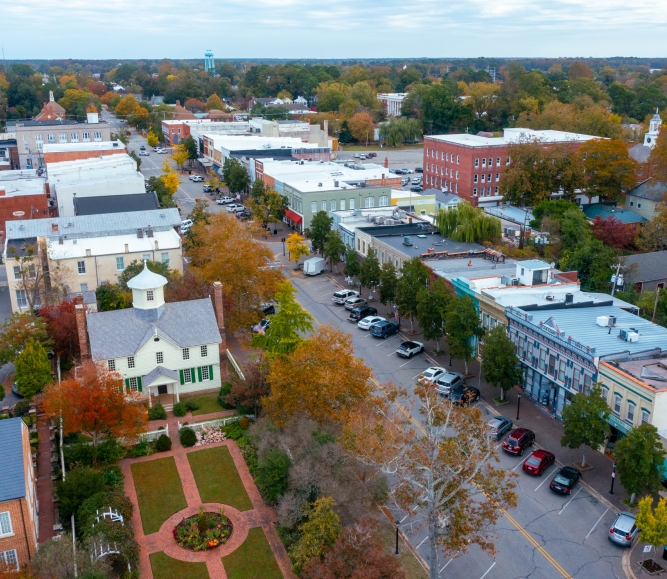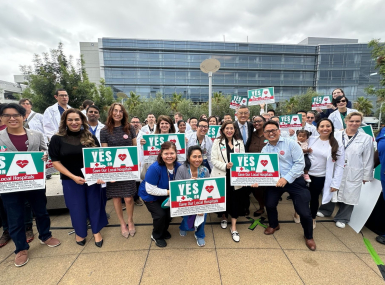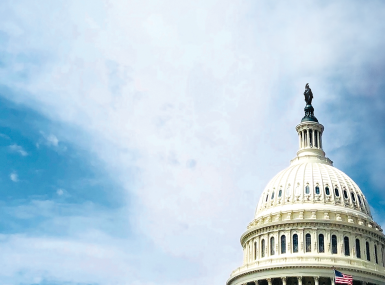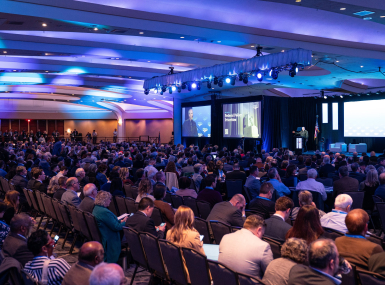Myths & Facts: American Rescue Plan Coronavirus State & Local Fiscal Recovery Funds

Upcoming Events
Related News
The Coronavirus State and Local Fiscal Recovery Fund (SLFRF), part of the American Rescue Plan Act (ARPA), allocated $65.1 billion in direct, flexible aid for every county, parish and borough in America.
Counties are on the front lines in delivering this aid to residents and strengthening the economy. Not only are counties responding to immediate needs caused by the COVID-19 pandemic, but county leaders are also using this opportunity to look ahead and build resiliency for our residents' future social and economic prosperity.
MythState and local government economies fared better than expected during the pandemic, so ARPA SLFRF dollars were unnecessary. |
FactWe don't know how counties would have fared without federal aid since federal aid was provided directly and indirectly to state and local governments since the earliest days of the pandemic in March 2020 with the passage of the CARES Act. However, NACo’s Counties Futures Lab research found in May 2020 that counties were facing a potential $144 billion budgetary impact through FY2021 as a result of COVID-19. With the aid provided through ARPA, state and local governments and our economies have already began recovering from the economic shock of the COVID-19 at a much faster rate when compared to the Great Recession. It took state and local governments nearly a decade to recover from the Great Recession whereas state and local governments are well on their way to recovery in terms of recovering revenue, expenditures and employment only 3 years after the start of the COVID-19 pandemic. |
MythDirect financial aid to counties through the ARPA SLFRF was used to bail out mismanaged state and local finances. |
FactAmerica's nearly 40,000 county elected officials and 3.6 million county employees are on the front lines of the nation's response to the coronavirus pandemic through the administration of public health and emergency response services and are responsible for delivering aid to our most vulnerable residents. Not only did this response to the pandemic require emergency spending, as counties continued to provide new and essential services to meet the increased demand, but the associated economic shutdowns also resulted (both directly and indirectly) in significant declines in county revenues, especially from the collection of property and sales taxes and program fees. In fact, according to NACo's research, 88 percent of counties reported that their budgets were impacted by COVID-19, with 72 percent reporting county expenditures increased and 60 percent reporting county revenues decreased in the first six months of the pandemic. Further, counties are responsible for driving recovery efforts. However, many are still confronting significant workforce shortage pressures at a time with growing, critical resident needs. In the first six months of the pandemic, local governments lost an estimated 1.2 million jobs, and 25 percent of counties had to cut the county workforce. Although the U.S. unemployment rate has returned to its pre-pandemic level, full recovery within local government jobs continues to lag with over 250,000 jobs yet to recover. This is still at a faster rate of recovery as compared to the Great Recession. |
MythCounties have only spent 2 percent of ARPA funds, and the U.S. Treasury is sitting on unobligated Recovery Funds that can be recouped. |
FactCounties received their SLFRF allocations in two tranches; the first 50 percent of the total award was distributed in the Summer and Fall of 2021, and the remaining 50 percent one year later in mid-to-late 2022. Simply put, the U.S. Treasury has already obligated nearly 100 percent of the $65.1 billion to America’s counties, parishes and boroughs. The Final Rule for how counties could invest these funds was published on January 6, 2022. The Local Government ARPA Investment Tracker established by NACo, Brookings Metro and the National League of Cities (NLC) shows that as of December 2022, 75 percent of ARPA SLFRF dollars have been obligated and budgeted. As the Treasury Department releases new data on county SLRFF investments, NACo and our partners continue to update the ARPA Investment Tracker. Additionally, counties have until December 31, 2024, to obligate ARPA SLFRF funds and until December 31, 2026, to expend funds. |
MythOnly nine percent of ARPA spending addressed COVID-19 and its impacts. |
FactWhile COVID-19 was a major public health crisis, it had widespread impacts on the industries and businesses that drive our local economies and exacerbated issues related to mental/behavioral health, access to affordable housing, and the workforce. Counties are responsible for providing a wide range of services to our citizens beyond public health and had to continue to do so amidst increased demand for these services. This included, but is not limited to, the administration of courts and the justice system, permits and records, elderly care and providing the community with broadband hot-spots. According to the law and Treasury's Final Rule, counties can use ARPA SLFRF dollars to respond to public health needs and mitigate negative economic impacts related to COVID-19 and for the provision of government services. According to the Brookings-NACo-NLC Local Government ARPA Investment Tracker, Tier 1 counties with populations of at least 250,000 residents have invested 43.2 percent in government operations, which includes a wide range of county services which can include public-health related investments; 14 percent directly in the public health response to COVID-19; 11 percent in community aid; 10 percent in infrastructure; 9.3 percent in housing; 8.2 percent in economic and workforce development; and 7.1 percent in public safety. |
MythSLFRF funds are being spent on private activities, including projects that have not addressed the impacts of COVID-19 or aligned with eligible uses under ARPA. |
FactPer the statute, SLFRF dollars can be used for a broad range of activities related to responding to the negative economic impacts of the pandemic. The Department of the Treasury’s Final Rule enumerates several eligible uses of funds, including assistance to households, small businesses, nonprofits and impacted industries, such as the hospitality and travel/tourism sectors. The bipartisan State, Local, Tribal and Territorial Fiscal Recovery, Infrastructure and Disaster Relief Flexibility Act, enacted as part of the Fiscal Year (FY) 2023 omnibus appropriations bill further expanded eligible uses to include transportation infrastructure, Community Development Block Grant (CDBG)-eligible and natural disaster related projects. Congress’ intent in authorizing the Recovery Fund was for counties to respond to the unique needs of our communities. Counties are investing these funds in eligible uses to revitalize communities and spur long-term recovery by addressing these broad negative economic impacts. |
MythThe ARPA SLFRF caused inflation. |
FactWhen the rate of inflation was high in the United States, it was also high throughout the world, a function of myriad factors. Compared to other major global economies such as the United Kingdom, Germany and Italy, inflation in the United States is relatively low and has eased in recent months. |
MythThere is no oversight of the ARPA SLFRF and recipients have no reporting requirements. |
FactBy law, SLFRF recipients must submit Project and Expenditure Reports to the U.S. Department of the Treasury on a quarterly or annual basis. Counties with over 250,000 residents or below 250,000 residents and an SLFRF award of more than $10 million are required to submit quarterly reports, and counties with populations below 250,000 residents and an award of less than $10 million are required to report on an annual basis. These reports are publicly available and easily accessible. As part of the P&E Report, recipients must identify how funds are being invested into a specific eligible project category, project obligations and expenditures, sub-awards and sub-recipients, and certify that they will use these funds within the bounds of the law when certifying to receive their award. Beyond these requirements, recipients must also comply with 2 CFR Part 200 – Uniform Administrative Requirements, Cost Principles, and Audit Requirements for Federal Awards, which contains extensive reporting requirements. |
MythSLFRF Funds were used to build jails and stadiums, which is an improper use of funds. |
FactAccording to the U.S. Treasury’s Final Rule, the construction of new correctional facilities to respond to increased crime, construction of new congregate facilities to decrease the spread of COVID-19, and construction of capital projects, such as stadiums, for general economic development purposes are all generally ineligible uses of SLFRF funds. Per regulations, SLFRF obligations and expenditures on capital projects outside of the revenue loss category must be directly related to the public health or negative economic impacts of COVID-19 (i.e. projects reported under Eligible Category (EC) 1 – Public Health and EC 2 – Negative Economic Impacts). SLFRF recipients may, however, use up to $10 million or up to the amount of actual revenue lost on the provision of any typical government service, which can include the construction or rehabilitation of correctional facilities (projects reported under EC 6.1 – Revenue Replacement). Many of these facilities were overpopulated due to the backlog in court cases because of the pandemic and had maintenance deferred as counties scrambled to protect the lives of our residents during the pandemic. Separately, local sports venues are often drivers of economic vitality in many communities and the negative economic effects of COVID were severe for these venues, The American Rescue Plan Act specifically enumerates “aid to impacted industries such as tourism, travel and hospitality” as one of four eligible uses of SLFRF funds. Local sports venues that support local tourism would therefore be eligible under this category. |
Resource
American Rescue Plan Resource Hub









